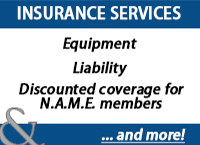
By Dave Austin, “The Music Professor”
Let’s face it – competition among DJs can be brutal. Even among ourselves, as friends and colleagues, we can find ourselves in competition with one another. And, it seems like new DJs are popping up almost daily. We can blame this on a number of factors: the availability of cheap or no-cost music on the internet, cheap and easily available DJ equipment commonly found in such discount outlets and other retailers. This all lends to the ability to jump into the DJ business with a very minimal investment. You may be able to point to other sources of competition…but the simple fact is – it’s out there and it doesn’t appear that the situation is going to get any better. So, we have little choice other than to deal with it and do the things we can to let potential customers know and understand why they should hire us and not the other guy.
Let me suggest ways we can promote our business and, just perhaps, give ourselves the needed edge to get the job. I’ve worked at a number of jobs over the years – I spent a substantial portion of my life in both radio and TV broadcasting and later in an advertising agency. I’ve also spent some time working in the print media. These experiences have served me well, allowing me to utilize them in promoting my DJ business, and today, I’d like to share some ideas which, hopefully, you can use.
In this article, I’d like to talk about what is considered the ultimate goal of almost all advertising campaigns. There’s a phrase in advertising called “Top of Mind Awareness (TOMA).” Even though you may not be familiar with the phrase, every day you’re exposed to Top of Mind Awareness advertising. This is the kind of advertising which attempts to have a specific brand or product come to mind when thinking of a particular industry…it’s also called “brand awareness.” You may have participated in one of those surveys which asks a question such as, “What particular product do you think of if I mention a talking green lizard?” TOMA is commonly used by larger companies for both promoting as well as surveying their businesses.
One of the best examples of TOMA is Coca-Cola. Can you recall any recent Coke ads which directly say “Go out and buy a Coke today”? Hardly, but what you may recall is, “I’d Like to Teach the World to Sing.” That commercial song was in 1971 and it is still highly recognizable even today and will forever be associated with Coke. The commercial was so popular in America that radio stations began contacting Coke and requesting a non-commercial version of the song with the line “I’d like to buy the world a Coke,” omitted.
A bit of music history here: The original commercial version of that song was done by a British group, the New Seekers. However, when it came time to record the new non-commercial rendition, the New Seekers were not immediately available, so a group calling itself the Hillside Singers recorded the song with a slight country and western flavor and released it as a single. Several weeks later, the New Seekers began their American tour and re-recorded the new lyrics and also released a single. Both versions sold well with the New Seekers version breaking into the Top 10 and the Hillside Singers’ version making it to number 13. It is today, more than 40 years later, still regarded as one of the best television commercials of all time. In fact, Coke advertising is legendary – remember Mean Joe Green giving the kid his jersey in exchange for a Coke? More recently, the polar bears chasing a bottle of coke through the snow? At Christmas, we expect to see old Santa knocking back a bottle of Coke in front of the fireplace, and very often, not a word is said.
How about Budweiser…what comes to mind first - A cold bottle of Bud or those Clydesdale horses? In our minds, they are one and the same. Come Super Bowl, we all hang on the TV waiting for the new Budweiser commercial. That, friends, is a demonstration of how effective and engaging TOMA can be.
Wouldn’t it be great if when a prospective bride begins thinking about her DJ, your company’s name just pops into her head? Fortunately, we can utilize TOMA on a smaller scale and it can be effective for us also.
Do you think employing the TOMA principle could help create an effective ad for your business? That’s going to depend, to a great extent, on your budget. A small ad run will not be nearly as effective as a larger run on multiple stations or outlets. With a small run, the TOMA survey might ask, “Do you recall seeing an advertisement about (subject of your ad)? (If yes) Who sponsored that ad?” Answer #1: I don’t know. Answer #2: Some DJ. Sadly, neither of these responses is what we looking for. So, what do you do?
It is a rule of advertising that repetition is the key to success. According to some sources, it may take as long as two weeks of multiple exposures before an ad begins to become effective. So, if you are unable or unwilling to purchase a sizeable run of your ad, the money may perhaps be more effectively spent elsewhere.
When planning and formulating your advertising, you may want to consider the latency or lasting effect of your message. A basic understanding of TOMA can be a effecting tool in your marketing program.





